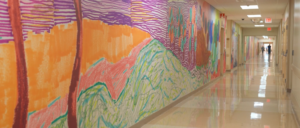Healthier Healing Spaces for All

In the world of healthcare design, creating spaces that are not only functional but also welcoming, clean, and sustainable is more important than ever. A focus on safety and hygiene is naturally paramount, but for a patient-centric approach to truly thrive, attention must also be paid to creating an environment that is warm, welcoming and conducive to healing.
In other words, sterile is great for equipment and surfaces, but not for how our surroundings make us feel.
Keeping all these needs in mind means that products need to perform and look great while doing it. Acrovyn® with Recycled Content (ARC) answers the call, enhancing both the longevity and aesthetic appeal of healthcare locations while aligning with environmental goals.
Construction Specialties (CS) launched Acrovyn in 2004 as the first complete PVC-free wall protection line, and it has long been a reliable healthcare solution. Recently, Acrovyn hit a new and very exciting milestone—it’s the first product of its kind to use post-consumer recycled content. Acrovyn’s formula now incorporates up to 50% recycled content, so it contributes to reducing waste, conserving resources, and lowering embodied carbon.
Each sheet of Acrovyn with Recycled Content contains the equivalent of about 130 plastic bottles. The updated resin is made by shredding single-use PET plastics, such as water bottles, and re-polymerizing them into durable, high-performance wall protection products.
Healthier Spaces for AllPeople. Buildings. Better. These three ideas captured in CS’ tagline guide our mission to provide inspired solutions for a more intelligently built environment. As a 75-year-old company, we think in generations, not days, and we want our products to last that long too.
Sustainability is ultimately about creating healthier spaces for people to live, work and heal. A sustainable business practice is an action that, when repeated, improves people and the environment more than it harms them.
Healthcare facilities consume vast amounts of resources in their daily operations, and there’s a growing emphasis on reducing environmental impact, conserving energy and adopting materials that contribute to long-term solutions.
Opting for material such as Acrovyn keeps PET bottles out of landfills and contributes to a circular economy—recycling the bottles reduces the need for virgin plastic and conserves natural resources.
Guarding Against What?When we talk about the importance of wall protection, what are we referring to? The most obvious answer is damage to the wall. From waiting rooms to corridors to patient rooms, high-use healthcare environments are subjected to constant foot traffic, equipment being moved, and routine cleaning, all of which can lead to significant wear and tear on interior surfaces.
Acrovyn’s suede-textured surface offers superior impact resistance for walls against scuffs, bumps, and scrapes, but wall protection protects people, too.
Products like handrails can be the difference between mobility and immobility for some patients as well as reducing the likelihood of slips, trips and falls. While this means that certain surfaces are going to be touched by many people every day, it is possible to select products that contribute to the fight against spreading germs.
In this case, that simply means Acrovyn is really easy to keep clean. It can be wiped down with most approved cleaning products, and, unlike Type II wallcoverings, Acrovyn’s shallow texture does not support the growth of bacteria or fungus, making it a hygienic and safe option for patient care areas.
Healing DesignAcrovyn’s cleanability lends itself to another fascinating aspect of healthcare—the effect of aesthetics on well-being. The perception of cleanliness isn’t as important as cleanliness itself, but clean-looking rooms communicate a lot. People correlate the condition of a healthcare building’s interior with patient care quality.

So, taking the idea of perception a step further, the right products can change the entire mood of a space. In facilities like Phoenix Children’s Hospital, for example, design is used as a tool for healing.
The hospital in Arizona wanted to renovate several areas to make them more welcoming and less intimidating for its young patients. One main corridor was long, windowless and anxiety-inducing for kids who often passed through it on their way to surgery.
The hospital’s advisory board decided on Acrovyn by Design® as the answer, due largely in part to it being highly customizable. In addition to ready-to-print patterns, Acrovyn by Design provides the option to embed almost any graphic, photo, or message behind Acrovyn. Establishing a wayfinding scheme has never been easier.
For that scary corridor in Phoenix Children’s Hospital, a contemporary artist created a mural on more than 60 sheets of paper using crayons, markers, and watercolors because those are the mediums kids would use, and it helps the artwork feel more accessible to youngsters. Now, kids look forward to that hallway instead of dreading it.
Incorporating sustainable materials like Acrovyn into healthcare design is an investment in the future. Architecture shapes patient journeys, so we provide strong, enduring solutions for your building.
hconews





